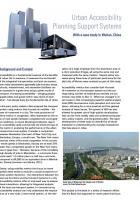Publications
The aim of this study is to help city authorities understand the dynamics of urban development in relation to transport in a rapidly growing Chinese city using the concept of accessibility.
Accessibility is a fundamental measure of the benefits of urban life. In essence, it measures the end benefit of the integrated transportation and land use system: how many destinations (generally jobs but also shops, schools, entertainment, and recreation) can be accessed in a given time using a given mode of transport. Increasing accessibility – bringing people, opportunities and goods within easy reach of each other – has always been the fundamental role of cities.
For the rapidly growing cities of the developing world (including but not limited to China, where this work was piloted), using accessibility measures to understand the role that land use and transport dynamics can have on the economic, social and environmental life of the city will be a powerful new tool. This study also goes one step further, using accessibility metrics in combination with a dynamic model of land use and transport that allows for the analysis of how current trends, policies, and plans will influence accessibility in future years.




